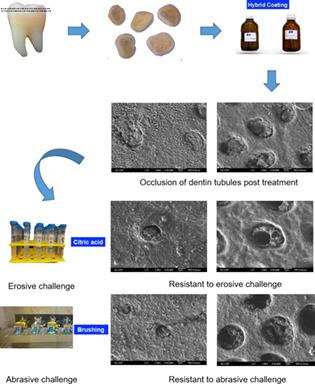当前位置:
X-MOL 学术
›
Microsc. Res. Tech.
›
论文详情
Our official English website, www.x-mol.net, welcomes your
feedback! (Note: you will need to create a separate account there.)
Chemical and mechanical resistance of novel experimental hybrid coatings on dentin permeability.
Microscopy Research and Technique ( IF 2.0 ) Pub Date : 2020-09-01 , DOI: 10.1002/jemt.23574 Tatiane Alexandre Oliveira 1 , Ernesto Anágua-Bravo 2 , Idalina Vieira Aoki 2 , Taís Scaramucci 1 , Maria Angela Pita Sobral 1
Microscopy Research and Technique ( IF 2.0 ) Pub Date : 2020-09-01 , DOI: 10.1002/jemt.23574 Tatiane Alexandre Oliveira 1 , Ernesto Anágua-Bravo 2 , Idalina Vieira Aoki 2 , Taís Scaramucci 1 , Maria Angela Pita Sobral 1
Affiliation

|
This study aimed to evaluate the capacity of novel experimental hybrid coatings (HC) to reduce dentin permeability and to verify their resistance to erosive and abrasive challenges. Dentin disc specimens (1 mm thick) were treated with 0.5 M EDTA solution and randomly allocated into three experimental groups (n = 10): Control (Saliva); Concentrated Hybrid Coating (TEOS/GPTMS/Y‐APS); and Diluted Hybrid Coating (1:3 ratio with distilled water). Dentin permeability was assessed by hydraulic conductance in the following experimental time periods: post‐EDTA, post treatment, post erosion (5 min in 0.05 M citric acid solution, pH = 3.8), and post abrasion (toothbrushing for 3,900 cycles). Dentin permeability percent was calculated with respect the values of post‐EDTA for each experimental time. The morphology of the surface of extra dentin specimens was examined by scanning electron microscopy (SEM) in the same time periods (n = 3). Permeability data were analyzed by two‐way repeated measures ANOVA and Tukey tests (p < .05). Both HC presented significantly lower dentin permeability than control post treatment and post erosion (p < .05), without difference between them (p > .05). Post abrasion, there were no significant difference among groups (p > .05). Post treatment and post erosion, the HC seemed to flow into the tubules, occluding them, while the tubules in control remained opened. Post abrasion, the tubules appear to be occluded in all groups. In conclusion, the experimental hybrid coatings were capable of reducing dentin permeability after treatment. They were also able to resist to erosive and abrasive challenges, with the advantage of forming thinner and colorless films that can be potentially used to treat dentin hypersensitivity.
中文翻译:

新型实验性混合涂层对牙本质渗透性的化学和机械阻力。
本研究旨在评估新型实验性混合涂层 (HC) 降低牙本质渗透性的能力,并验证其对侵蚀和磨蚀挑战的抵抗力。牙本质盘标本(1 mm 厚)用 0.5 M EDTA 溶液处理并随机分为三个实验组(n= 10):对照(唾液);浓缩混合涂层(TEOS/GPTMS/Y-APS);和稀释的混合涂层(与蒸馏水的比例为 1:3)。在以下实验时间段通过水力传导评估牙本质渗透性:EDTA 后、处理后、侵蚀后(在 0.05 M 柠檬酸溶液中 5 分钟,pH = 3.8)和磨损后(刷牙 3,900 次循环)。根据每个实验时间的后 EDTA 值计算牙本质渗透率百分比。在相同的时间段(n = 3)通过扫描电子显微镜(SEM)检查额外牙本质标本的表面形态。通过双向重复测量方差分析和 Tukey 检验分析渗透率数据(p < .05)。两种 HC 的牙本质渗透性均显着低于对照处理后和侵蚀后 ( p < .05),两者之间没有差异 ( p > .05)。磨损后,各组之间没有显着差异(p > .05)。处理后和侵蚀后,HC 似乎流入小管,阻塞它们,而控制中的小管保持打开状态。磨损后,小管似乎在所有组中都被阻塞。总之,实验混合涂层能够降低治疗后的牙本质渗透性。它们还能够抵抗侵蚀和磨损的挑战,其优势是形成更薄且无色的薄膜,可用于治疗牙本质过敏症。
更新日期:2020-09-01
中文翻译:

新型实验性混合涂层对牙本质渗透性的化学和机械阻力。
本研究旨在评估新型实验性混合涂层 (HC) 降低牙本质渗透性的能力,并验证其对侵蚀和磨蚀挑战的抵抗力。牙本质盘标本(1 mm 厚)用 0.5 M EDTA 溶液处理并随机分为三个实验组(n= 10):对照(唾液);浓缩混合涂层(TEOS/GPTMS/Y-APS);和稀释的混合涂层(与蒸馏水的比例为 1:3)。在以下实验时间段通过水力传导评估牙本质渗透性:EDTA 后、处理后、侵蚀后(在 0.05 M 柠檬酸溶液中 5 分钟,pH = 3.8)和磨损后(刷牙 3,900 次循环)。根据每个实验时间的后 EDTA 值计算牙本质渗透率百分比。在相同的时间段(n = 3)通过扫描电子显微镜(SEM)检查额外牙本质标本的表面形态。通过双向重复测量方差分析和 Tukey 检验分析渗透率数据(p < .05)。两种 HC 的牙本质渗透性均显着低于对照处理后和侵蚀后 ( p < .05),两者之间没有差异 ( p > .05)。磨损后,各组之间没有显着差异(p > .05)。处理后和侵蚀后,HC 似乎流入小管,阻塞它们,而控制中的小管保持打开状态。磨损后,小管似乎在所有组中都被阻塞。总之,实验混合涂层能够降低治疗后的牙本质渗透性。它们还能够抵抗侵蚀和磨损的挑战,其优势是形成更薄且无色的薄膜,可用于治疗牙本质过敏症。











































 京公网安备 11010802027423号
京公网安备 11010802027423号